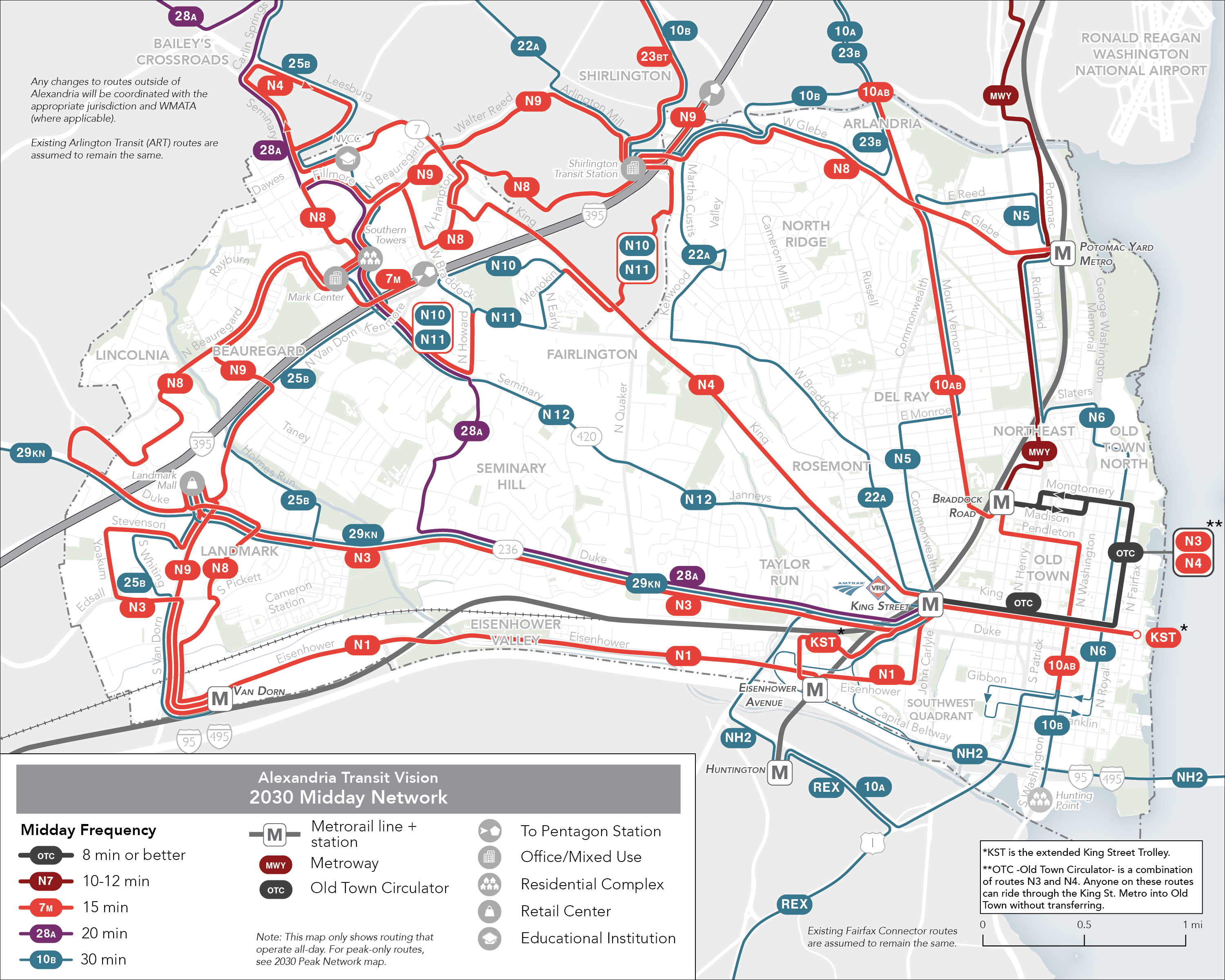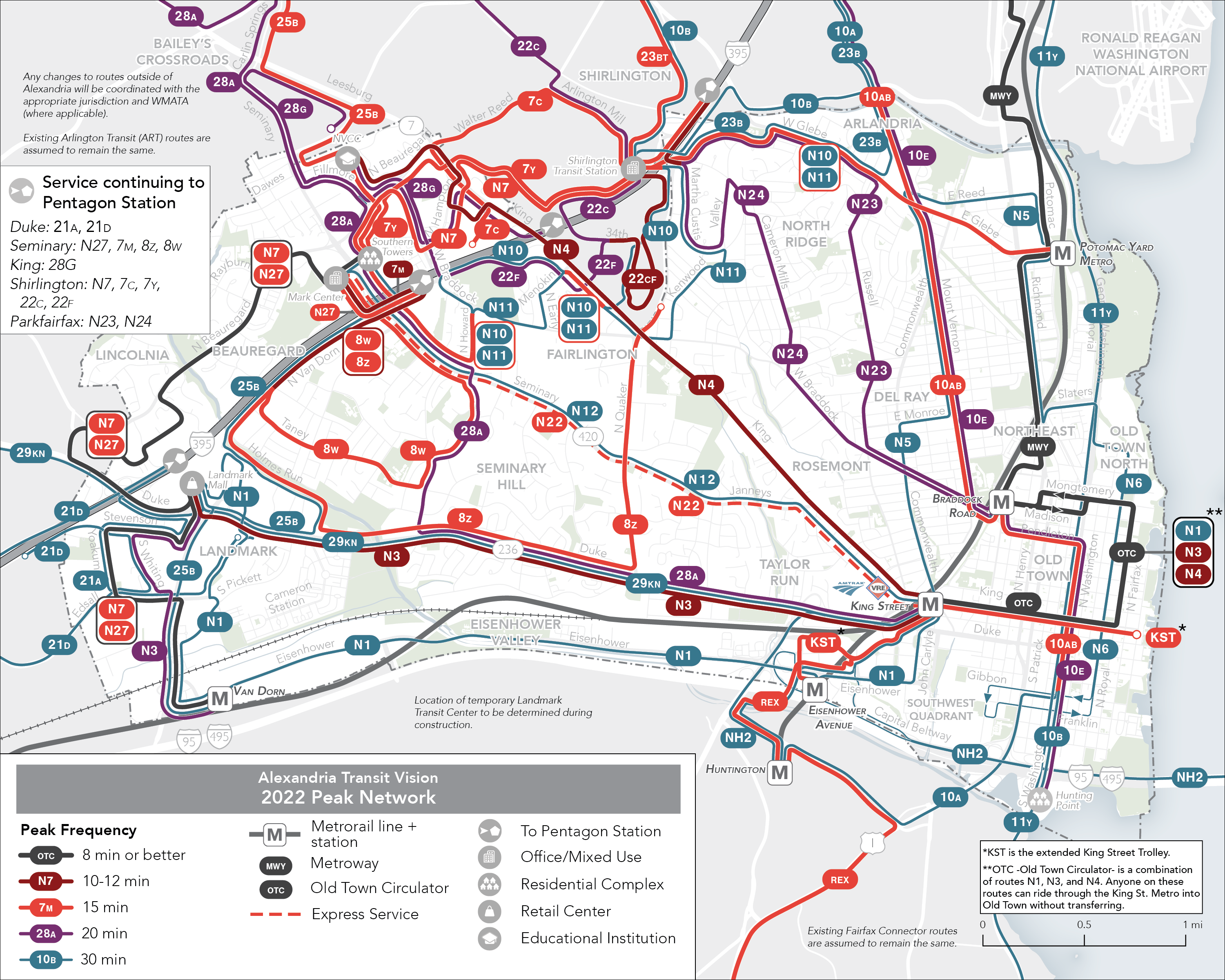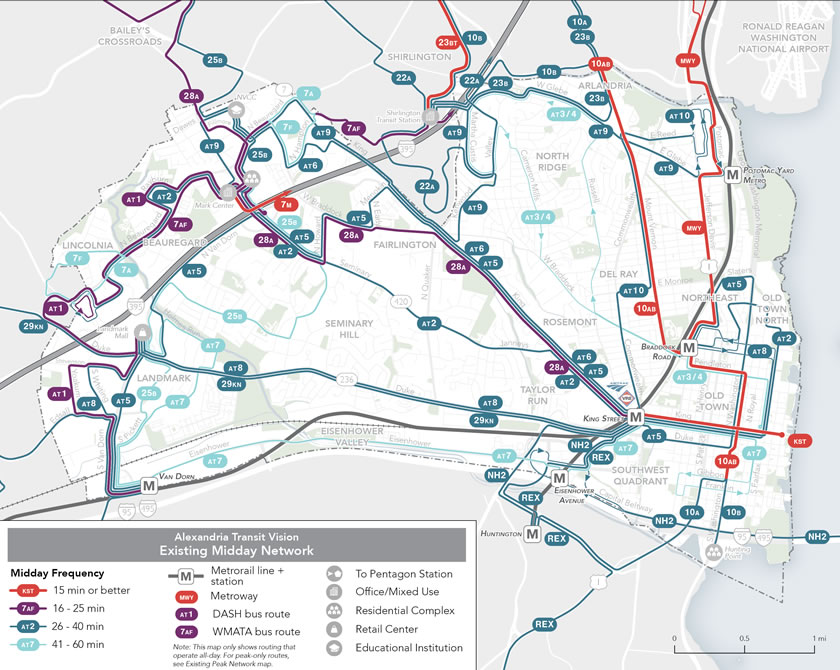Alexandria Transit Vision Plan

The first phase of the 2022 ATV Plan - now called the "New DASH Network" - launched on September 5, 2021. For more information and to submit questions or feedback, please visit dashbus.com/newnetwork
Overview
ATC (DASH) Board Adoption of ATV Plan
After nearly two years of planning, outreach and discussion, the Alexandria Transit Vision (ATV) Plan bus network for 2030 and the short term 2022 "major growth" network were both adopted by the Alexandria Transit Company (DASH) Board of Directors at their December 11, 2019 meeting. The new bus networks will provide more useful bus service for the City of Alexandria by introducing frequent, all-day bus service to areas where more people will be able to use it. The new bus networks will significantly increase access to frequent transit for low income, minority and senior residents, while establishing important bus connections to the future Potomac Yard Metrorail Station and other key development areas.
In the fall 2019, the ATV team conducted an extensive public outreach campaign with hearings, meetings, pop-up events, and surveys to collect feedback on the draft recommended 2030 and 2022 networks. Based on the input received, the draft network proposals were adjusted to create the Final ATV Network recommendations that were adopted by the DASH Board of Directors on December 11, 2019.
The biggest change made to the draft ATV networks based on community input was the addition of weekday-only bus service on Seminary Road and Janneys Lane. A new "N12" route will replace the current AT-2 route segment that was initially proposed for elimination due to low ridership. To encourage "N12" usage, the Board set a benchmark to monitor future ridership on Seminary Road and Janneys Lane (between King Street Metrorail Station and Howard Street), and determine if the route should continue in the future. The final ATV networks also maintain current AT3 (proposed "N23") and AT4 (proposed "N24") routes from Braddock Road Metrorail Station to the Pentagon.
The implementation of the plan for DASH routes in the 2022 ATV Network will be outlined in the 2022 DASH Transit Development Plan (TDP), which informs the annual DASH budget request to City Council. WMATA route changes will be considered during the WMATA FY2022 budget process. If adopted by Council and WMATA, the new ATV network would launch by Summer 2021. The long-term 2030 ATV network will be implemented by 2030 through the same annual DASH and WMATA processes.
Although the 2022 ATV network is not planned for implementation until July 2021, DASH recently introduced major service improvements on the AT-1 Plus and AT-9 that represent an intermediate step between the current network and the 2022 ATV network. These changes will provide shorter wait times and more off-peak service, which were two of the central goals of the ATV Plan. These improvements were 100% funded by I-395 Express Lane toll revenues through NVTC’s I-395 Commuter Choice Program.
The ATV Board memorandum from the December 11, 2019 meeting of the DASH Board of Directors can be found at: https://www.dashbus.com/events/atc-board-directors-meetings.
Alexandria Transit Vision Fast Facts
- The creation of a city-wide, high frequency network with buses running every 15 minutes or better, all day, seven days a week in the West End, Landmark, Arlandria, Potomac Yard, and Old Town.
- Access to useful, frequent, all-day transit for 120,000 residents (vs. 40,000 today)
- 89% of low-income residents will have access to frequent, all-day transit (vs. 29% today)
- 87% of minority residents will have access to frequent, all -day transit (vs. 22% today)
- Maintains existing bus service in most areas so that 99.5% of existing bus boardings are still within 1/8 mile of a stop in the proposed 2030 ATV Network
- Significantly expands off-peak service, including a 50% increase in weekend service. Most DASH routes will operate all day on Saturdays and Sundays with buses coming every 15 - 30 minutes
To learn more about the ATV Project, you can:
- Use the isochrone tool to see how far you can go with transit at noon on weekday with the ATV Recommended Networks in 2022 and 2030 compared to today’s network
- Review maps of the Final Recommend Network
- Read the Final Recommended Report for detailed analysis and explanation of the proposed networks.
- Read shorter, neighborhood-by-neighborhood blurbs about how various communities within the City might be impacted by the draft networks.
- Watch our short videos about the ATV and the Draft Recommended Networks: Video 1 | Video 2
Final Recommended Network
Peak Network by 2030

Midday Network by 2030

Peak Network by 2022

Midday Network by 2022

Existing Peak Network

Existing Midday Network

Neighborhood Impacts of Draft Recommended Network
- Arlandria
- Del Ray
- Duke Street / Landmark
- Eisenhower East / Carlyle
- Old Town
- Parkfairfax / North Ridge
- Potomac Yard
- Seminary Hill / Janneys Lane
- Southern Towers / Mark Center
- King Street / Park Center / Bradlee
- Van Dorn Street
- West End / Beauregard Street
Past DASH Board and Transportation Commission meetings
Alexandria Transit Company Board Meeting - December 11, 2019
The Alexandria Transit Company (DASH) Board met on December 11, 2019 to make its final recommendations and adopt the ATV Network Plan. The Board adopted the final 2030 ATV Network Plan (20% added service hours), and the 2022 Major Growth ATV Network Plan (8% added service hours). The Board supported the inclusion of a proposed route "N12" on Seminary Road and Janneys Lane, that should be funded through other service reductions, such as reducing the peak headways on the proposed "N1" route along Eisenhower Avenue from every 15 minutes to every 30 minutes in the Final 2022 scenario. Further, the Board recommended that a ridership benchmark should be used to monitor future performance of Route N12.
Alexandria Transit Company Board Meeting - June 12
The Alexandria Transit Company (DASH) Board met on June 12, 2019 to provide guidance to the project team on the development of a draft recommended network, as well as near term and longer term service levels, based on the input received on the Ridership concept and Coverage concept. The Board recommended that the ATV network be designed with approximately 85 percent of service hours dedicated to ridership oriented goals. Approximately 15 percent of service hours should be allocated for coverage type services, with an emphasis on maintaining transit access for areas with significant numbers of seniors and individuals with limited mobility. The final draft ATV network will also be designed with a focus on peak services such as the AT-3 and AT-4 in light of the extensive public feedback that has been received.
In terms of future levels of investment, the Board recommended that the ATV Plan network should target a 20 percent increase over current service hours by the year 2030. For the short term, the Board recommended that the plan look at three scenarios of service level increases by FY 2022, including no increase, an 8 percent increase, and 4 percent increase to better understand the potential fiscal impacts over the next two years.
Alexandria Transit Company Board Meeting - May 8
The public was invited to provide input on the ATV as part of the regularly-scheduled May 2019 meeting of the Alexandria Transit Company (DASH) Board.
Transportation Commission - April 17
The public was invited to provide input on the ATV as part of the regularly-scheduled April 2019 meeting of the Transportation Commission.
Joint Alexandria Transit Company (ATC) Board / Transportation Commission Meeting - February 13, 2019
A joint ATC Board and Alexandria Transportation Commission meeting was held on Wednesday, February 13, 2019. The meeting provided an update on the ATV Plan and an overview of transit network scenarios that were developed based on community input.
Reports and Plans
Final Recommended Network Report (Coming Soon)
The ATV Project Team has developed a final Recommended Network report. This report provides the adopted recommendations for a near term (2022) and longer term (2030) transit network based on community input from the third round of engagement, and the adopted network from the DASH Board.
Draft Recommended Network Report
he ATV Project Team has developed a draft Recommended Network report. This report provides draft recommendations for a near term (2022) and longer term (2030) transit network based on community input from the first two rounds of engagement and direction from the DASH Board. The draft networks were derived from the concepts that were developed in the Concepts Report (See below).
Engagement Round #2 Summary of Input
A summary of Engagement Round #2 during Spring 2019 including input provided by the MetroQuest survey, stakeholder workshop and three public workshops
Concepts Report
The Concepts Report provides an overview of two concepts for what bus networks could look like in Alexandria, including a Ridership concept, and Coverage concept. These provide two different ideas that were examined during the second round of civic engagement (spring 2019). These concepts were developed based on feedback from the public, and the results of the Choices Report.
Engagement Round #1 Summary of Input
A summary of Engagement Round #1 during Fall 2018 including input provided by the public survey, stakholder workshop, and two public workshops.
Choices Report
The draft final Choices Report is provided below. The Choices Report was the first step of the project, and lays out the facts about transit and development in Alexandria, and discusses value choices and trade offs that need to be made as part of the transit vision.
Project Background
The ATV Plan is a result of the close partnership between DASH and the City of Alexandria. DASH is the Alexandria transit agency that provides bus service within Alexandria and connects to Metrobus, Metrorail and Virginia Railway Express. Both the City and DASH recognize the need to address declining transit ridership, changing land use patterns, shifting regional travel, and recent technological advances. The ATV Plan represents an opportunity to fundamentally re-imagine the city’s bus network from scratch.
The study is funded through federal funds (Regional Surface Transportation Program – RSTP) provided via the Virginia Department of Rail and Public Transit (DRPT ). Similar network redesign efforts have recently been conducted in cities such as Houston, TX; Tampa, FL; Richmond, VA; and San Jose, CA.
Project Overview
The ATV Plan developed an unconstrained, data-driven future bus transit network that reflects the needs and priorities of city residents, workers and visitors. The plan used data to understand issues and needs and a robust civic engagement process to guide City and DASH staff on how buses should serve the community. The City has made some major investments in its transit network, based on the recommendations of the Transportation Master Plan. These include the construction of the Route 1 Metroway, and planning efforts for the West End Transitway and Duke Street Transitway. It is expected that these major investments will serve as a backbone toward the future transit network.
The key project tasks included:
- Civic Engagement – An inclusive civic engagement process with outreach to citizens, businesses, existing and potential transit riders, and other key stakeholders. Outreach will be focused on three phases:
- Identify issues, needs, and community values with respect to transit service
- Solicit feedback on proposed network concepts
- Review draft ATV Plan
- Analysis of the Current Transit System – Data collection during spring 2018 for all existing transit routes in the City and route analysis to understand how the existing system is running
- Market Assessment – Analysis of the existing and future bus transit demand that includes understanding population and employment characteristics, travel patterns, future growth areas, and transportation technology trends
- Network Design – Development of the future transit network in two phases:
- Two conceptual transit networks for public consideration
- Final ATV Plan network recommendations. While no specific horizon year is identified, the ATV Plan will be designed so that it could realistically be implemented within the next 10-20 years. The ATV Plan also will include near-term recommendations that could be implemented during the next 2-3 years
Project Schedule
The ATV Plan began in spring 2018, and was completed in December 2019. The implementation of any recommended changes would likely begin in mid to late 2021.
